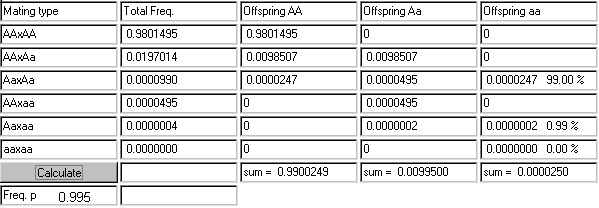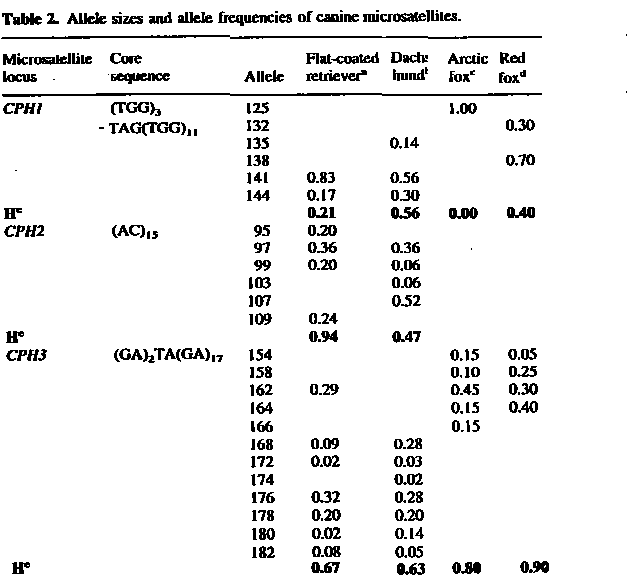
When the gene frequencies in a population are known, the genotype frequencies for each genotype under H-W conditions can be calculated. Correspondingly the mating type frequencies under random mating can be calculated by means of the multiplication rule for probabilities, results shown in the table below. Note that when the two genotypes are different, there has to be multiplied with 2, as the two types can be combined in reverse orders.
| Offspring segregation | |||||
| Mating type | Frequency | AA | Aa | aa | |
| AA x AA | p2 x p2 | = p4 | 1 | ||
| AA x Aa | 2 x p2 x 2pq | = 4p3 x q | 0.5 | 0.5 | |
| Aa x Aa | 2pq x 2pq | = 4p2 x q2 | 0.25 | 0.5 | 0.25 |
| AA x aa | 2 x p2 x q2 | = 2p2 x q2 | 1 | ||
| Aa x aa | 2 x 2pq x q2 | = 4pq3 | 0.5 | 0.5 | |
| aa x aa | q2 x q2 | = q4 | 1 |
Calculation of mating type frequencies is important in relation to control of monogenetic inherited diseases. This
topic will be discussed more detailed in chapter 5, where the classical segregation in offspring
will be submitted to
statistical analysis.
An applet for
calculation of mating type frequencies can be seen below
Example of use of the applet is shown below where q=0.005. The 99% of the recessive offspring come from normal parents.

Gene frequencies also have a large area of application within bred studies. The gene frequencies for closely related breeds have a tendency to lie closer each other than not so closely related breeds.

The above shown table gives the results from a study of the albumin types in Danish dog breeds. As mentioned in section 2.1 a fast and a slow albumin allele occur when serum is tested on an electrophoreses gel. These alleles have the designations F and S. The frequencies of the S allel varies from 0 to 1 in the dog breeds. The investigations have been carried out by K. Christensen et al. 1985; Hereditas, 102:219-223.
In the table below are the results from a study of some mikrosatellites in Danish dog breeds, as well as in the red and the blue foxes. Here are results from three loci each with several alleles, being named as the length of the DNA-string being amplified by the primers. The frequencies vary significantly between the dog breeds. The primers which are developed in the dog work equally well in both fox species. This indicates a large degree of genetic homology between dogs and foxes. He gives the information content of the loci. This depends on the percentage of heterozygotes in the population concerned. Genetically the heterozygotic animals are the most informative. In paternity tests or other genetic investigations the homozygotes give very little or no information about which of the parents' alleles an offspring has inherited. The investigations have been carried out by M. Fredholm et al. 1995; Mamalian Genome, 6:11-18.
